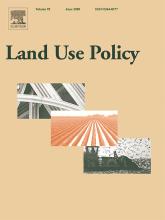Resource information
The design of efficient Green Infrastructure —GI— systems is a key issue to achieve sustainable development city planning goals in the twenty-first century. This study’s main contribution is the identification of potential GI elements to better align the environmental, social and economic perspectives in the GI design by including information about the use, activities, preferences and presence of people. To achieve this, user generated content from Location Based Social Network —LBSN— Foursquare is used as a complementary data source. This involved the construction of an interdisciplinary correlation framework, between the Landscape Ecology principles and the GI elements, that included the classification of Foursquare data into grouping types. The classification considered the potential role of Foursquare venues in the GI network. Valencia City in Spain served as an illustrative case study to test the validity of the proposed method. The results suggest that Foursquare can provide a valuable insight on user perceptions of potential GI elements. Moreover, the findings indicate that user generated content from LBSNs like Foursquare can serve as a complementary tool for analysing the dynamics of urban outdoor spaces to assess GI network, thereby facilitating more effective urban planning and contributing to the social sustainability of the city.


